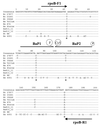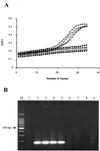Utilization of the rpoB gene as a specific chromosomal marker for real-time PCR detection of Bacillus anthracis
- PMID: 11472954
- PMCID: PMC93078
- DOI: 10.1128/AEM.67.8.3720-3727.2001
Utilization of the rpoB gene as a specific chromosomal marker for real-time PCR detection of Bacillus anthracis
Abstract
The potential use of Bacillus anthracis as a weapon of mass destruction poses a threat to humans, domesticated animals, and wildlife and necessitates the need for a rapid and highly specific detection assay. We have developed a real-time PCR-based assay for the specific detection of B. anthracis by taking advantage of the unique nucleotide sequence of the B. anthracis rpoB gene. Variable region 1 of the rpoB gene was sequenced from 36 Bacillus strains, including 16 B. anthracis strains and 20 other related bacilli, and four nucleotides specific for B. anthracis were identified. PCR primers were selected so that two B. anthracis-specific nucleotides were at their 3' ends, whereas the remaining bases were specific to the probe region. This format permitted the PCR reactions to be performed on a LightCycler via fluorescence resonance energy transfer (FRET). The assay was found to be specific for 144 B. anthracis strains from different geographical locations and did not cross-react with other related bacilli (175 strains), with the exception of one strain. The PCR assay can be performed on isolated DNA as well as crude vegetative cell lysates in less than 1 h. Therefore, the rpoB-FRET assay could be used as a new chromosomal marker for rapid detection of B. anthracis.
Figures


 , Bacillus sp. strain Ba813_11; 5, +, Bacillus anthracis Vollum; 6, ●, Bacillus cereus 27877; 7, ◊, Bacillus cereus 23261; 8, −, Bacillus sp. strain Ba813_12; 9, ▴, Bacillus thuringiensis BtB8. (B) Gel electrophoresis of the PCR products. Lanes, M: 100 bp DNA ladder; 1, negative control (no DNA); samples 2 to 9 are the same as in panel A.
, Bacillus sp. strain Ba813_11; 5, +, Bacillus anthracis Vollum; 6, ●, Bacillus cereus 27877; 7, ◊, Bacillus cereus 23261; 8, −, Bacillus sp. strain Ba813_12; 9, ▴, Bacillus thuringiensis BtB8. (B) Gel electrophoresis of the PCR products. Lanes, M: 100 bp DNA ladder; 1, negative control (no DNA); samples 2 to 9 are the same as in panel A.
 , Bacillus anthracis A74; ●, Bacillus anthracis 0074; +, Bacillus anthracis Texas 0077; −, Bacillus anthracis ΔANR-1099; ○, Bacillus anthracis 7700; ◊, Bacillus anthracis A58; □, Bacillus cereus 14579; ♦, Bacillus thuringiensis 10792.
, Bacillus anthracis A74; ●, Bacillus anthracis 0074; +, Bacillus anthracis Texas 0077; −, Bacillus anthracis ΔANR-1099; ○, Bacillus anthracis 7700; ◊, Bacillus anthracis A58; □, Bacillus cereus 14579; ♦, Bacillus thuringiensis 10792.References
-
- Anonymous. Bioterrorism alleging use of anthrax and interim guidelines for management—United States, 1998. Centers for Disease Control and Prevention JAMA. 1999;281:787–789. - PubMed
-
- Ash C, Farrow J A, Dorsch M, Stackebrandt E, Collins M D. Comparative analysis of Bacillus anthracis, Bacillus cereus, and related species on the basis of reverse transcriptase sequencing of 16S rRNA. Int J Syst Bacteriol. 1991;41:343–346. - PubMed
-
- Bernardi L, Vitale G, Montecucco C, Musacchio A. Expression, crystallization and preliminary X-ray diffraction studies of recombinant Bacillus anthracis lethal factor. Acta Crystallogr D Biol Crystallogr. 2000;56:1449–1451. - PubMed
Publication types
MeSH terms
Substances
Associated data
- Actions
- Actions
- Actions
- Actions
- Actions
- Actions
- Actions
- Actions
- Actions
- Actions
- Actions
- Actions
- Actions
- Actions
- Actions
- Actions
- Actions
- Actions
- Actions
- Actions
- Actions
- Actions
- Actions
- Actions
- Actions
- Actions
- Actions
- Actions
- Actions
- Actions
- Actions
- Actions
- Actions
- Actions
- Actions
- Actions
- Actions
- Actions
LinkOut - more resources
Full Text Sources
Other Literature Sources
Molecular Biology Databases

